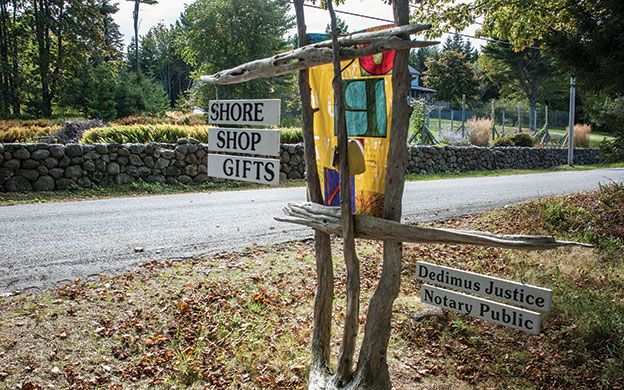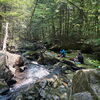Processing Your Payment
Please do not leave this page until complete. This can take a few moments.
- News
-
Editions
View Digital Editions
Biweekly Issues
- December 1, 2025
- Nov. 17, 2025
- November 03, 2025
- October 20, 2025
- October 6, 2025
- September 22, 2025
- + More
Special Editions
- Lists
- Viewpoints
-
Our Events
Event Info
Award Honorees
- Calendar
- Biz Marketplace
On Isle au Haut, Maine's economic woes are magnified
 Photo / James McCarthy
Lobster boats on the harbor of Isle au Haut. Nearly 50% of the community's year-round residents make their living as lobstermen.
Photo / James McCarthy
Lobster boats on the harbor of Isle au Haut. Nearly 50% of the community's year-round residents make their living as lobstermen.
 Photo / James McCarthy
Kendra Chubbuck and her husband, John DeWitt, run a gift shop that sells products from 23 Isle au Haut residents. An 8-year-old girl sold $600 worth of lobster through the store.
Photo / James McCarthy
Kendra Chubbuck and her husband, John DeWitt, run a gift shop that sells products from 23 Isle au Haut residents. An 8-year-old girl sold $600 worth of lobster through the store.
 Photo / James McCarthy
On Isle au Haut’s town wharf, a sculpture by folk singer Gordon Bok highlights the island’s lobstering tradition.
Photo / James McCarthy
On Isle au Haut’s town wharf, a sculpture by folk singer Gordon Bok highlights the island’s lobstering tradition.
 Photo / James McCarthy
Shore Shop Gifts is owned by Kendra Chubbuck and her husband, John DeWitt.
Photo / James McCarthy
Shore Shop Gifts is owned by Kendra Chubbuck and her husband, John DeWitt.

Spend a day on Isle au Haut and you'll return to the mainland with bits of conversation jockeying for attention with the passing scenery as the mail boat Otter traverses the island-dotted seven-mile passage back to Stonington.
“We've had our ups and downs since I've lived out here. I've done a lot of jobs I didn't want to do, but I did them because I had to. I've made it out here by doing just about everything.”
“I love this place. That's one thing all of us would agree on. We love the island. There are some things we disagree on, but that's the one thing we agree on.”
“I think the island community would be lost without the store. It's as much a gathering place as it is a store.”
“The island is aging. We definitely need more families with kids coming out here.”
“Life is so much fuller here. I'm happier here than I've ever been anywhere else.”
“You better love the one you're with, because there's a lot of face time out here, especially during the winter.”
“The mail boat is the lifeline of the island.”
By the time I step off the mail boat onto the dock in Stonington, I have but one firm conclusion: Making a living off the coast of Maine is immensely complex and challenging.
I also realize the entrepreneurial spirit you might find on a small island community like Isle au Haut, with a year-round population of just under 40 residents, has less to do with making things and everything to do with building a sustainable community.
Lacking a diversified economy
Isle au Haut, six miles long and two miles wide, includes part of Acadia National Park. It is one of 15 year-round island communities in Maine, yet is among those with a tenuous hold on year-round sustainability. It faces many of the issues faced by small towns throughout Maine — an aging population, a lack of jobs and a limited workforce — magnified by the fact that its entire year-round population would fit in a typical small-town diner.
The “Island Indicators 2015” report provides the latest snapshot of the challenges facing Isle au Haut and 14 other year-round island communities, updating demographic, economic and social data for those communities last published in 2012. Heather Deese, vice president of research and strategy for the Island Institute, says the report highlights the intrinsic economic challenge those island communities face, which is that everything costs more than on the mainland — food, energy, health care, building supplies. An “acute” lack of affordable housing, limited employment opportunities and aging populations complicate those challenges.
Deese says 74% of Isle au Haut's year-round residents are self-employed. The island has 18 active offshore lobstering licenses, she adds, accounting for almost half the island's year-round population.
“For most of the islands along the coast, the local economy is completely dependent on offshore lobstering,” she says. “It used to be much more diversified 20 years ago. So that's a risk.”
Since 1990, island populations overall have increased 5.7% as compared to the state's overall growth of 8.2%. But most of that increase has been in Casco Bay, the report states. Isle au Haut, for example, reported a population of 45 in spring 2014, down 38.36% from the 2010 U.S. Census figure of 73.
The median age on the 15 year-round islands remains significantly higher than the state as a whole, with Isle au Haut reporting 31% of its households having one or more people over age 65. That's another risk, as Deese writes in her report: “This continuing trend may have implications for the strength of island-based workforces, schools and community diversity.”
Overall student enrollment for the 15 islands has declined 18% since 2002. Enrollment at Isle au Haut's one-room school currently is five students. “Schools are a central component of a year-round island community,” the report states. “Given the small size of many island schools, slight enrollment declines can be cause of concern.”
But Deese says Maine's islands have a long history of meeting their challenges head-on — citing as examples the end of the great age of sail and the demise of granite-quarrying — and says it's no less true today.
“The islands are so determined to keep their community strong,” she says. “They are continually building the economic base they need to sustain themselves well into the future.”
Top problem? Affordable housing
Tall, thin and solidly built, John DeWitt makes his living as a lobsterman. But he's also a carpenter, mason and skilled woodworker who's building with his wife, fifth-generation islander Kendra Chubbuck, a new home at Head Harbor. He also serves as the town's first selectman, an elected position that carries with it administrative duties that in a larger town would be handled by a town manager.
“I think right now the island is in a tough spot,” he says. “Anything goes: If anyone can make a living doing something, it's fine. Most fishermen only do fishing. Some do wood-cutting or light carpentry. There are some carpenters on the island who do caretaking work along with the carpentry. There are still a couple of diehards saying fishing is the only way to be out here, but that's changing as the population declines.”
DeWitt estimates the island's year-round population is 35 people, 10 less than the 2014 estimate included in the Island Indicators 2015 report. “It goes up and down. It was about that number when I first arrived in 1972, then in the '80s and '90s it got up to around 50 people.”
Enrollment at the island's K-8 school has been as low as one student and as high as 14 during that time. “We're excited we have five kids right now,” says Chubbuck, who serves on the school board. “One family moving on or off the island makes a big difference. All the small island schools depend so much on families with school-age children being able to make their living on the island.”
DeWitt says the economic challenges faced by Isle au Haut are inter-related and are shared by most of the year-round islands. In his view, the lack of affordable housing is the No. 1 problem. “You are limited to what kind of work you can get here,” he says, “but nobody can come out here to do anything unless they have a place to live.”
DeWitt says the Isle au Haut Community Development Corp., a nonprofit, focuses on providing affordable rental housing. In 2013, in a public-private partnership with Maine State Housing Authority, it built two energy-efficient affordable homes and now owns and manages four rental houses.
“All the houses are filled up now,” DeWitt says.
One of the tenants is Rozalyn Santospago, who lives with her lobsterman husband and their children. For the past two summers, she has managed the Maine Lobster Lady food truck, which is owned by her mother, Diana Santospago. The food truck caters primarily to day trippers, selling lobster rolls, fried clams, whoopee pies and homemade cookies and a fried haddock sandwich that some say is worth the fare to the island. Its season runs from 4th of July to Labor Day.
“The more things going on out here the more people want to check them out,” she says. “We're profitable. I have to make a profit, or it's not worth it.”
Island visitors add value
DeWitt admits he has misgivings about the island's economy being so exclusively dependent on lobstering. “Guys are going at it like this is going to go on forever,” he says. “I don't think it is. Unfortunately, I don't think there is that much else we can be doing.”
Tourism, he says, “is the last little asset that Isle au Haut has.”
Kendra Chubbuck's ties to the island go back five generations. “I came out here as a kid,” she says, recalling long summer stays with her grandmother and great aunt and uncle at Head Harbor on the island's southern end. “I always knew I was going to retire out here. I love it here.”
Her island “retirement” after working 15 years as loan and housing administrator at Coastal Enterprises Inc. coincides with her 2012 marriage to DeWitt and moving from the mainland to the island with a pet llama and some geese. DeWitt's lobster boat was their moving van. They opened Shore Shop Gifts that same year. It's become Chubbuck's full-time job during the summer tourism season.
The gift shop is 300 feet from the town landing. It used to be DeWitt's workshop. Now it's the way they pay for their Affordable Care Act health insurance and car insurance. It also provides a source of income for 23 islanders who sell something there, including an 8-year-old girl who asked if Chubbuck would be willing to sell the lobsters she catches in the summer to tourists.
“She has 10 traps and goes out with her father,” Chubbuck says. “I've given her over $600 this year. She's saving it for college. She's a third-grader and one of the 23 islanders represented by our gift shop.”
“Whenever someone buys something, I tell them who made it,” she adds, noting that over the past five years the gift shop has had visitors from every continent other than Antarctica. “They love the stories. I'll tell them that's an actual mussel shell from Isle au Haut. It's important to have things made by islanders.”
Visitors play an increasingly important role in the island economy.
“Tourism does help the island,” says Chubbuck, noting that visitors provide revenues for the island's ferry service that minimize the cost otherwise borne by islanders. Likewise, they provide additional business that helps sustain the Island Cooperative Store. “If we didn't have the day trippers, the kayakers and schooners, we'd be lost.”
The Acadia National Park connection
A major draw, obviously, is Acadia National Park, which carefully manages its 2,900 acres on Isle au Haut (roughly half the island) as a low-density recreational experience that places a high value on solitude. Acadia spokesman John Kelly says the park's Isle au Haut district had approximately 7,000 visitors by Aug. 31, up 2.7% from the same period in 2015. That's in line with the 5,000 to 7,500 day use visitors and 500 to 600 campers Isle au Haut has averaged in recent years.
While those numbers pale in comparison to the overall 3 million visitors Acadia expects for its 2016 centennial anniversary year — which would be the highest number since 1989 — Kelly says neither the park nor the island is pushing for a dramatic increase. By statute, since the 1980s the park had limited daily usage of its Isle au Haut district to 90 day-use visitors and 30 campers — but those limits were nudged slightly upward in the park's October 2014 management plan to 128 visitors per day.
“It's as close to a 'wilderness' experience as you can get in Acadia National Park,” he says. “We haven't had any negative feedback from the people who go to Isle au Haut about their experience out there.”
As for the historic ambivalence islanders might have felt about the park 30 or more years ago, seasonal resident Judith Burke — who with her artist husband converted the turn-of-the-century lightkeepers' house at Robinson Point Light into the Keeper's House Inn — sees a different attitude now. “I don't think the town cares anymore,” she says. “We need the tourists.”
Burke figures she and her husband probably employed just about every resident of the island at some point during their 23 years of running the inn. “We were full 80% of the time,” she says.
They sold the inn in late 2012 to Marshall Chapman, who's carrying on the traditions they established.
Brianna Warner, economic development director at the Island Institute, gives high marks to Isle au Haut and the islands for taking ownership of their overarching problem of continuing to be sustainable year-round communities. They're all crafting unique solutions to their housing and employment challenges, including new opportunities to expand aquaculture and eco-tourism. They're finding ways to collaborate on lowering their energy costs as well as improving their high-speed internet capacity to lure “telecommuting” entrepreneurs attracted to island living.
“So many people who have deep roots on these islands, who've survived there for ages, really respect the idea of being an entrepreneur,” she says. “That's why these islands are so special. They don't sit around and whine about a problem. They do something about it.”
Read more
Island Institute report cites need for broadband on year-round islands
Downeast economy already reeling from clam flat closures
$143K in fed funds for island communities awarded to Island Institute
Select mud flats reopen for shellfish harvesting
Further thoughts on Isle au Haut: Entrepreneurs by necessity
Mainebiz web partners

The Giving Guide
The Giving Guide helps nonprofits have the opportunity to showcase and differentiate their organizations so that businesses better understand how they can contribute to a nonprofit’s mission and work.
Learn More
Work for ME
Work for ME is a workforce development tool to help Maine’s employers target Maine’s emerging workforce. Work for ME highlights each industry, its impact on Maine’s economy, the jobs available to entry-level workers, the training and education needed to get a career started.
Learn More
Groundbreaking Maine
Whether you’re a developer, financer, architect, or industry enthusiast, Groundbreaking Maine is crafted to be your go-to source for valuable insights in Maine’s real estate and construction community.
Learn more-
The Giving Guide
The Giving Guide helps nonprofits have the opportunity to showcase and differentiate their organizations so that businesses better understand how they can contribute to a nonprofit’s mission and work.
-
Work for ME
Work for ME is a workforce development tool to help Maine’s employers target Maine’s emerging workforce. Work for ME highlights each industry, its impact on Maine’s economy, the jobs available to entry-level workers, the training and education needed to get a career started.
-
Groundbreaking Maine
Whether you’re a developer, financer, architect, or industry enthusiast, Groundbreaking Maine is crafted to be your go-to source for valuable insights in Maine’s real estate and construction community.
ABOUT
NEW ENGLAND BUSINESS MEDIA SITES
No articles left
Get access now
In order to use this feature, we need some information from you. You can also login or register for a free account.
By clicking submit you are agreeing to our cookie usage and Privacy Policy
Already have an account? Login
Already have an account? Login
Want to create an account? Register
Get access now
In order to use this feature, we need some information from you. You can also login or register for a free account.
By clicking submit you are agreeing to our cookie usage and Privacy Policy
Already have an account? Login
Already have an account? Login
Want to create an account? Register







Comments